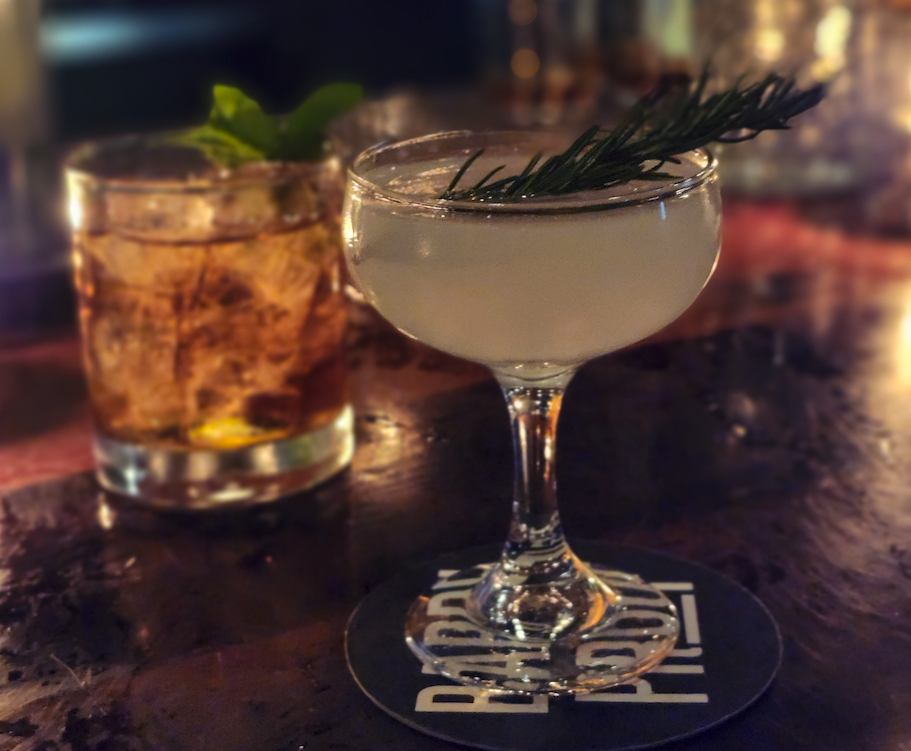Curiosity is key, in both poetry and mixology

for Tales of the Cocktail 2024, boasts an aromatic sprig of rosemary.
My writing retreat started with drinks at a friend’s apartment downtown. For years now, we’ve been carving out time to see each other when I come up to Knoxville for my annual-ish writing retreat at the amazing Firefly Farms. I try to drive in a night early so we can make time to talk, drink, and play, often with homemade cocktails.
When I got to Shane’s, we greeted each other and wandered towards the kitchen, where I emptied my bag of treats onto the island: half a bottle of Chartreuse, homemade arancello, and some homemade olive bitters another friend had given me the night before. He talked excitedly about the new pineapple syrup he had made, how it was slightly funky and he wasn’t sure yet what to do with it. Together, we got to work, brainstorming what we’ve had recently at our local favorites (Cure and Brother Wolf), comparing some feisty new drinks to the classics, and thinking about balance.
Neither of us are experts, but we are passionate. We’ve read enough recipes and watched enough professionals to figure out a little bit. We know that building a cocktail is about form and creativity. It’s about seasonality, personality, and terroir. We study structure to know what works, then twist and experiment, perhaps with a specific goal in mind, or just to see what happens.
And isn’t that just like a poem? To take these pieces of ourselves, in language, and see how they go together? To study the existing structures but make them your own?
play is crucial to both of these arts, as is revision

Tales of the Cocktail, an annual conference celebrating the history of the cocktail and the industry, unfolds every July in New Orleans. This year’s celebration was not only filled with fun flavors but was also fruitful for me as a writer. Each year, I love to attend the international bar pop-ups, brand-sponsored happy hours, and industry pool parties where the world’s best bartenders and brand ambassadors mix work and play.
One event I was particularly excited about in 2024 featured foraged items: the menu was literally a walk through the land. Sitting down to this menu was akin to a tour, a physical experience. Each drink had its own unique nose and taste, resonant of a specific place, and curated by the folks who saw an opportunity for shared nourishment.
There’s something special about watching people do what they know best, what they’re passionate about. There’s something inspiring about reading each menu and seeing just how much personality comes through in each recipe, shifting with each specific ingredient, each creator’s creativity, and the balance between all elements.
building a cocktail is about form and creativity.
It’s about seasonality, personality, and terroir.
And isn’t that just like a poem?
Curiosity is key, in both poetry and mixology. We need to think about what patterns work and which don’t. We too recognize how one subtly tweak can turn something familiar on its head. We put the same ingredients (words) into new recipes that create something fresh and unique (order). The strongest poems and the best cocktails contain an element of surprise deeply embedded in the familiar.
I think of Margaret Atwood’s “[you fit into me],” published online at The Poetry Foundation. The poem begins with one couplet: “you fit into me / like a hook into an eye.” At first, this image feels familiar, comfortable. These are two things that are meant to fit together! However, the second couplet turns that image on its head: “a fish hook / an open eye.” The image of connection turns gruesome just by using alternate meanings of the words “hook” and “eye.” Each word is modified in a way that surprises the reader, creating something unexpected and shocking. The words “fish” and “open” are like bitters or citrus peel: modifiers to the original recipe that yield something beyond the expected flavor profile.
There are no guaranteed results, of course, but thinking back to that night in Shane’s kitchen, I can say for certain that play is crucial to both of these arts, as is revision. At the end of the evening, I tried making a strange amaro and cherry recipe with a local Knoxville gin (Postmodern Giniferous), and the flavor profile didn’t work at all. But we split the drink in half and each tweaked our portion, thinking of juniper berries and balance. What local ingredients could shift this from an Italy-forward drink to something straight from the holler?
We ended up with two variations that worked in very different ways, though both delighted. And isn’t that just like workshopping a poem?
_______
Stacey Balkun (she/her) is the author of Sweetbitter & co-editor of Fiolet & Wing. Her creative work has appeared in Mississippi Review, Pleiades, and several other anthologies and journals. Winner of the 2024 Holdich Scholarship Award and the 2024 SAMLA Graduate Student Essay Award, Stacey holds a PhD from the University of Mississippi, and teaches poetry in the MFA program at UNO as well as online at The Poetry Barn.

